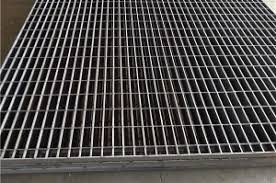Comprehensive Guides on Grating
Regarding architectural elements seamlessly blending form and function, metal grating is a timeless choice. Whether you’re an architect, designer, or simply someone looking to enhance the aesthetics and utility of a space, gratings offer a world of possibilities. This comprehensive guide delves deep into the world of gratings, exploring their various types, applications, and critical factors to consider when choosing the perfect one for your project.

Send Enquiry
The Many Faces of Grating:
Gratings come in a variety of materials, each with its unique set of characteristics and applications:
Steel Grating: Strength Meets Durability
Steel gratings are renowned for their robustness and longevity. They are the go-to choice for industrial settings where heavy loads and high foot traffic are expected. They Provide following benefits:
- Exceptional support and anti-slip properties.
- Making them ideal for platforms.
- Walkways.
- Even stair treads.
Aluminum Grating: Lightweight and Corrosion-Resistant
If you’re seeking a lightweight yet durable solution, aluminum gratings are the answer. Their corrosion-resistant properties make them perfect for outdoor applications. They are frequently used in environments where moisture and exposure to the elements are a concern, such as marine settings or coastal structures.
Stainless Steel Grating: The Pinnacle of Corrosion Resistance
When corrosion resistance is paramount, stainless steel gratings shine. These gratings are the epitome of durability and are often chosen for applications in demanding environments like chemical plants, food processing facilities, and wastewater treatment plants.
Fiberglass Reinforced Plastic (FRP) Grating: Versatility and Customizability
FRP gratings offer unparalleled versatility and can be tailored to various design aesthetics. They are corrosion-resistant and provide electrical insulation, making them suitable for multiple applications, including pedestrian walkways, platforms, and pool surrounds.
Applications of Grating
Now that we’ve explored the different types of gratings let’s delve into their vast array of applications:
Industrial Settings
They are pivotal in industrial settings, serving as platforms, catwalks, and flooring. With their exceptional load-bearing capacity, steel gratings are often used in manufacturing plants, warehouses, and distribution centers.
Architectural and Decorative
Gratings are not merely functional but also a striking architectural element. Aluminum and stainless steel gratings can create visually appealing facades, sunscreens, and fences, adding an aesthetic touch to any building.
Transportation and Infrastructure
The transportation sector also benefits from the versatility of gratings. They are used in bridges, highways, and tunnels to provide structural support while allowing water and debris to pass through, reducing the risk of corrosion and erosion.
Safety and Security
Gratings are essential for safety in various settings. They are commonly used as safety barriers, machine guards, and anti-slip surfaces in environments where worker safety is a top priority.
Choosing the Right Grating:
Selecting the suitable grating for your project is crucial. Here are the key factors to consider:
Load-Bearing Capacity
Determine the expected load that the grating will bear. Steel gratings excel in high-load scenarios, while FRP gratings are suitable for lighter loads.
Corrosion Resistance
Consider the environment in which the grating will be installed. Opt for stainless steel or FRP gratings if exposed to corrosive substances or moisture.
Aesthetics
For architectural projects, aesthetics matter. Aluminum and stainless steel gratings offer sleek and modern designs, while FRP gratings can be customized to match your desired look.
Safety Features
In areas where slip resistance is critical, prioritize gratings with anti-slip properties, such as serrated surfaces or applied coatings.
Maintenance and Longevity
Regular maintenance is essential to ensure the longevity of gratings. Depending on the material, maintenance requirements may vary. Stainless steel and FRP gratings typically require less upkeep than steel and aluminum.
Explore the world of gratings and unlock their full potential
Gratings are versatile architectural elements that find applications in various industries and projects. Choosing the correct type of grating, considering factors like load-bearing capacity, corrosion resistance, aesthetics, and safety features, is paramount to the success of your project.
Whether you’re looking to enhance the functionality of an industrial facility, add a touch of elegance to a building’s façade, or improve safety in a high-traffic area, gratings offer a solution that combines durability and style. You can elevate your project to new heights with the right gratings.

